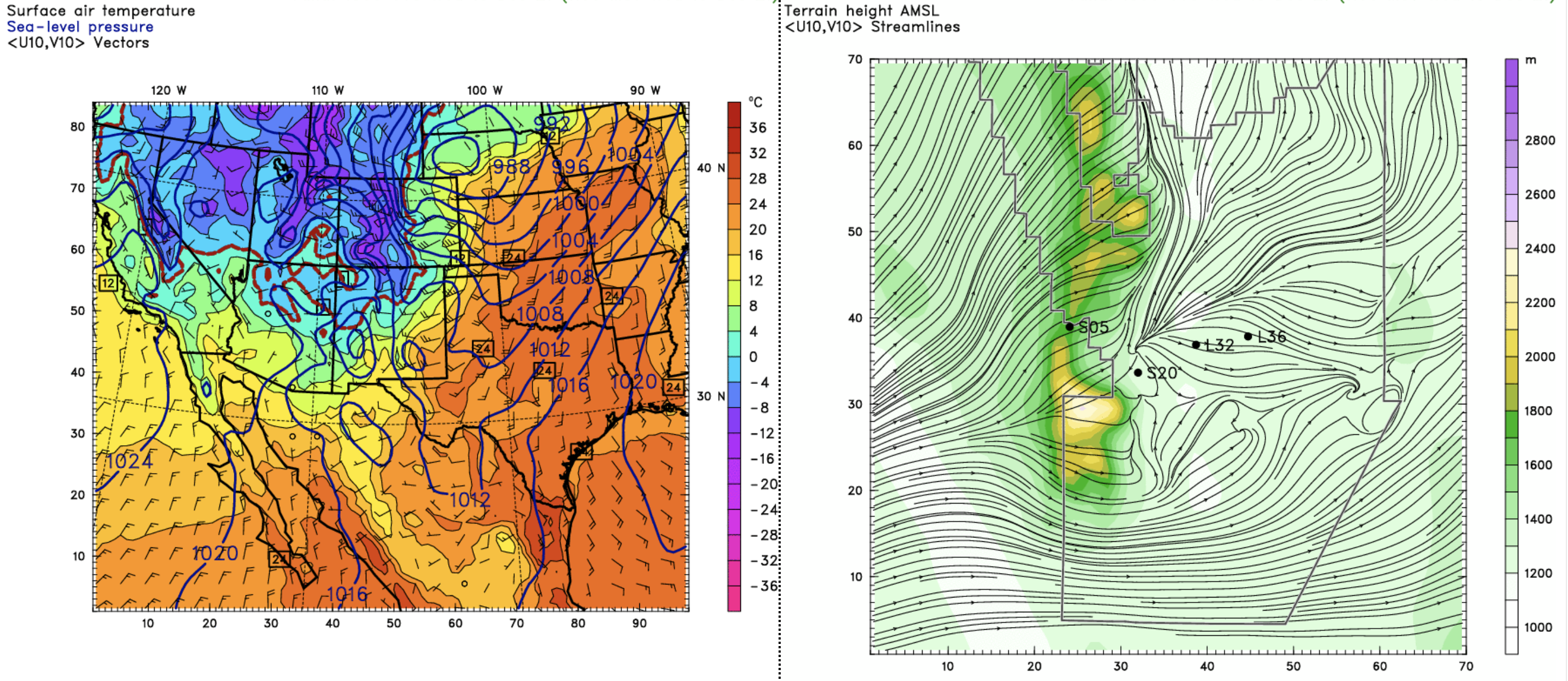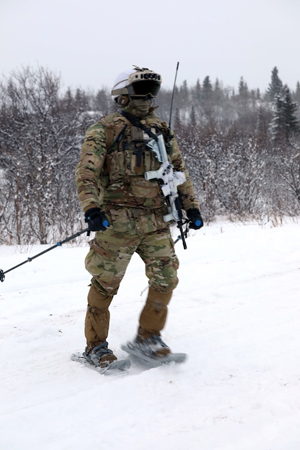Better forecasts, enhanced national security
NCAR’s ATEC project saves Army money while advancing meteorological technologies
Dec 21, 2021 - by David Hosansky
Dec 21, 2021 - by David Hosansky

These examples of 4DWX model output show temperature and pressure (left) and terrain height (shaded) and streamlines, which are the atmospheric gradients along which winds typically blow (right).
When the National Center for Atmospheric Research (NCAR) embarked on a project in the mid-1990s to improve forecasts at U.S. Army test ranges, few could have imagined the extent to which the work would help spur foundational prediction technologies.
Over the past quarter century of collaborations with the U.S. Army Test and Evaluation Command (ATEC), NCAR scientists and engineers have built a completely new meteorological support infrastructure called Four-Dimensional Weather (4DWX), contributed to flagship forecasting tools, and developed techniques to predict atmospheric conditions on scales smaller than a city block.
At the same time, they helped the Army evaluate the effectiveness of weapons systems in a broad range of weather conditions and saved the military millions of dollars that would have been lost because of needing to reschedule tests at the last minute due to unfavorable conditions. Severe weather can also cause additional costs during tests, such as damage to aircraft from hail.
“This sustained collaboration with the Army has substantially improved the state of forecasting,” said Scott Swerdlin, director of NCAR’s National Security Applications Program. “I’m very proud that we have provided critical support for national security while advancing our understanding of the atmosphere in ways that have benefited society.”
The ATEC collaboration has grown to the point that it encompasses eight Army test ranges across the United States as well as supporting temporary missions at test facilities overseas. In addition to helping the Army test missiles and other weapons systems, it provides technology to track potentially deadly toxins in the atmosphere and evacuate civilians in the event of a biological or chemical attack.
“Accurate, timely, high-precision weather forecasting and analysis are vital for conducting and refereeing outdoor U.S. Army materiel developmental tests,” said Scott Halvorson, who has served as a meteorologist with ATEC for more than 20 years. “The ATEC 4DWX program has continuously exceeded our requirements for over 20 years, and its nimbleness allows it to rapidly adapt to changing mission requirements and environments. Ultimately, 4DWX has fertilized opportunities for many ATEC weather forecasters to grow unbounded, which has resulted in world-class meteorological support that can’t be bought.”
The U.S. Army relies on test ranges to evaluate military technologies that are under consideration for procurement. The tests must avoid particular atmospheric risks — for example, lightning would create safety hazards for fueling and munitions-handling operations, and strong upper-level winds would carry debris from surface-to-air missiles off range. For that reason, the Army needs both reliable forecasts as well as “nowcasts” before and during tests.
If a test has to be canceled at the last moment due to unforeseen weather conditions, hundreds of thousands of dollars could be lost from unnecessarily mobilizing personnel and equipment.
Following a test, the Army develops detailed estimates of atmospheric conditions in order to better evaluate the performance of weapons systems. These post-test analyses draw on sensor observations as well as computer modeling and specialized mathematical methods known as data assimilation to fill in the gaps between sensor locations.
Faced with these requirements, ATEC (which was then known as TECOM, for Test and Evaluation Command) in 1995 gave NCAR the assignment of evaluating its meteorological services. Commanders wanted to find out from leading scientists and engineers if it would be possible to create more reliable and fine-scale predictions, especially given the varying conditions at its geographically dispersed test ranges.
“The extraordinary thing at the time was they were seeking the best science and not just bidding this out for the lowest cost,” Swerdlin said.
Swerdlin and his NCAR colleagues toured several of the ranges, getting a first-hand look at their meteorological operations and identifying a number of factors that needed improvement. These included data quality control, archival, and retrieval capabilities; modeling capabilities for fine-scale forecasts; and simulations of chemical diffusion and sound propagation.
Over the next several years, NCAR and ATEC worked together to develop the initial version of the 4DWX system, which continues to be refined and updated. The system provides information about meteorological processes in the three dimensions of space, as well as time.
The 4DWX system consists of two major components — one that assimilates meteorological data and the other that generates forecasts. The first component, known as RT-FDDA (for real-time four-dimensional data assimilation) ingests observations as they become available and applies statistical techniques to define the current conditions of the atmosphere. The second component uses the Weather Research and Forecasting (WRF) model to draw on those conditions and produce specialized forecasts that currently go out to 120 hours.

The research team developed probabilistic forecasts, replacing a single model run with an ensemble of model runs, each with slightly different initial atmospheric conditions and model physics. This enabled forecasters to bound the range of uncertainty, providing ATEC with the probability of a certain type of weather (such as a 30% chance of 5-10 mph winds over the middle of the range in the early afternoon, a 60% chance of 10-20 mph winds, and a 10% chance of more than 20 mph). These probabilities could be applied to different parts of the range and to different times of day or night. Such information was considerably more useful than a deterministic forecast, such as simply predicting 10-20 mph winds in the afternoon.
Scientists and engineers have carefully tailored the 4DWX system to meet the specific climatological conditions of each range. At the White Sands Missile Range in New Mexico, for example, meteorologists need to correctly forecast summertime storms that are spun up by the North American monsoon. At the Aberdeen Test Center in Maryland, they contend with ocean breezes, squall lines in the spring and summer, and frigid air in the winter that can remain wedged between the Appalachian Mountains and Chesapeake Bay for days on end. The Cold Regions Test Center in the shadow of the majestic mountain range that includes Denali presents very different challenges, with high winds and extremely cold wintertime temperatures that can vary across short distances by more than 20° Celsius (36° Fahrenheit).
The NCAR team has also developed specialized forecasting products. For example, sound propagation models look at such atmospheric conditions as temperature inversions and windshear to determine when loud blasts from tests are least likely to affect nearby neighborhoods. Similarly, ballistic trajectory and missile-debris-drift models help forecast winds and turbulence that could cause a missile to stray outside the boundaries of a test range.
“It has been exciting to see all the progress on short-term forecasts and specialized forecasts, especially in such a range of different climates,” said Swerdlin. “The science on this project was groundbreaking.”
The development of accurate predictions in a variety of meteorological conditions has produced substantial dividends for researchers and forecasters, with ongoing collaborations between ATEC meteorologists and NCAR experts providing new insights into atmospheric patterns. NCAR members of the 4DWX team have drawn on their experience to help contribute to coding for WRF, which has become an internationally prominent weather model.
“The test range sites serve as real-world meteorological laboratories,” said Jason Knievel, current principal investigator of the 4DWX project and the deputy director for science of NCAR’s National Security Applications Program. “The R&D done for ATEC has resulted in material improvements to one of the most widely used numerical weather prediction models in the world.”
One of the most important applications of 4WDX technology is its ability to predict the movement of toxic substances released into the air, either by accident or through a deliberate release. In the aftermath of the Sept. 11, 2001, terrorist attacks, this technology formed the basis of a special project, called Pentagon Shield, in which scientists studied how best to protect the Pentagon and its more than 25,000 occupants. Their goal was to use atmospheric observations and very fine-scale modeling of wind and other meteorological conditions to enable officials to adjust the building’s ventilation systems and map out evacuation routes in the event of a biological, chemical, or radiological attack. The technology has also been applied to high-profile events that could attract terrorist threats, including the summer and winter Olympics.
This very detailed modeling approach has inspired other technological innovations. These include a new NCAR model known as FastEddy®, which can simulate the swirling eddies and other turbulence of street canyons in such detail and with such computational speed that it offers the promise of predicting weather for delivery drones and other small aerial vehicles.
The Auto-Nowcaster is another major innovation that grew out of NCAR’s ATEC work. This system ingests observations in real time from radars, surface stations, satellites, and other instruments, and then applies computer models to generate nowcasts out to two hours every 6-10 minutes. Initially designed to provide short-term predictions of thunderstorms, the technology has been applied to local wind fields and clouds in ways that help utilities predict wind and solar energy production.
Looking ahead, Swerdlin said he wants to draw on artificial intelligence techniques for improved predictions, including more detailed and reliable short-term forecasts in the 0- to 6-hour range. In addition, he is hoping to start using immersive visualizations to provide forecasters with more realistic training.
“It’s difficult to think of another project that has produced as many benefits as ATEC, both for our national security and for the scientific community,” Swerdlin said. “It has been an incredibly productive 25 years, and I’m eager to see what lies ahead.”